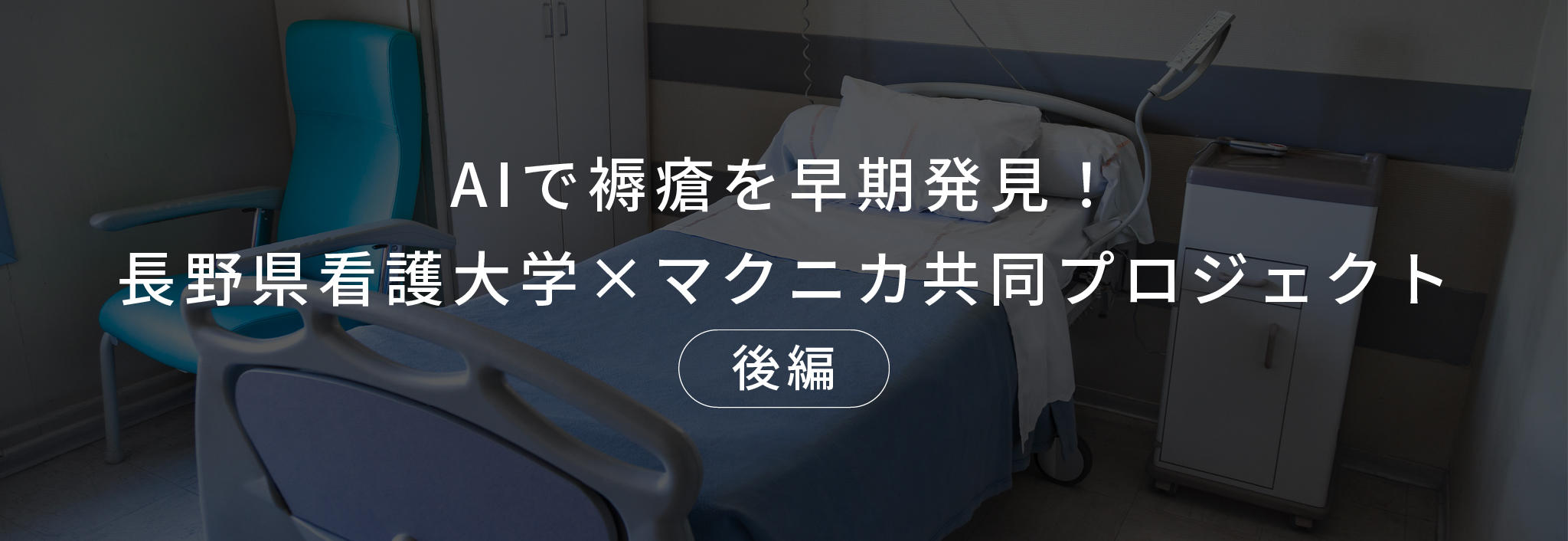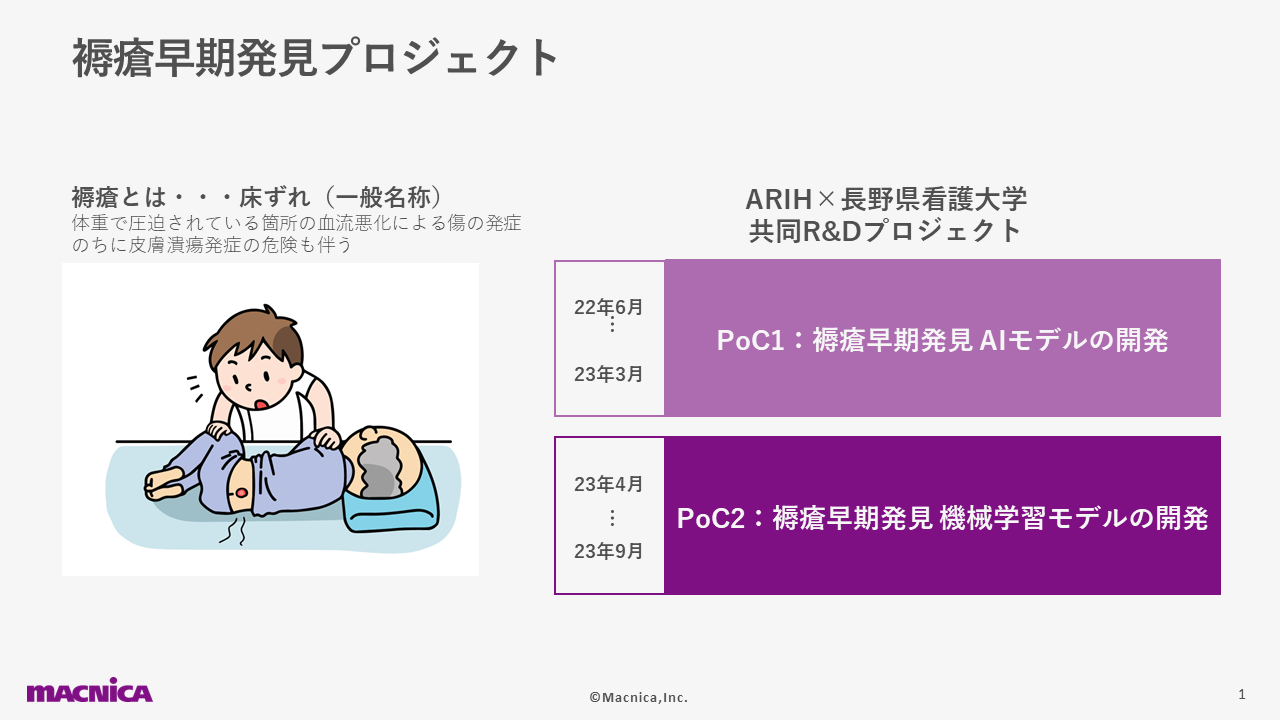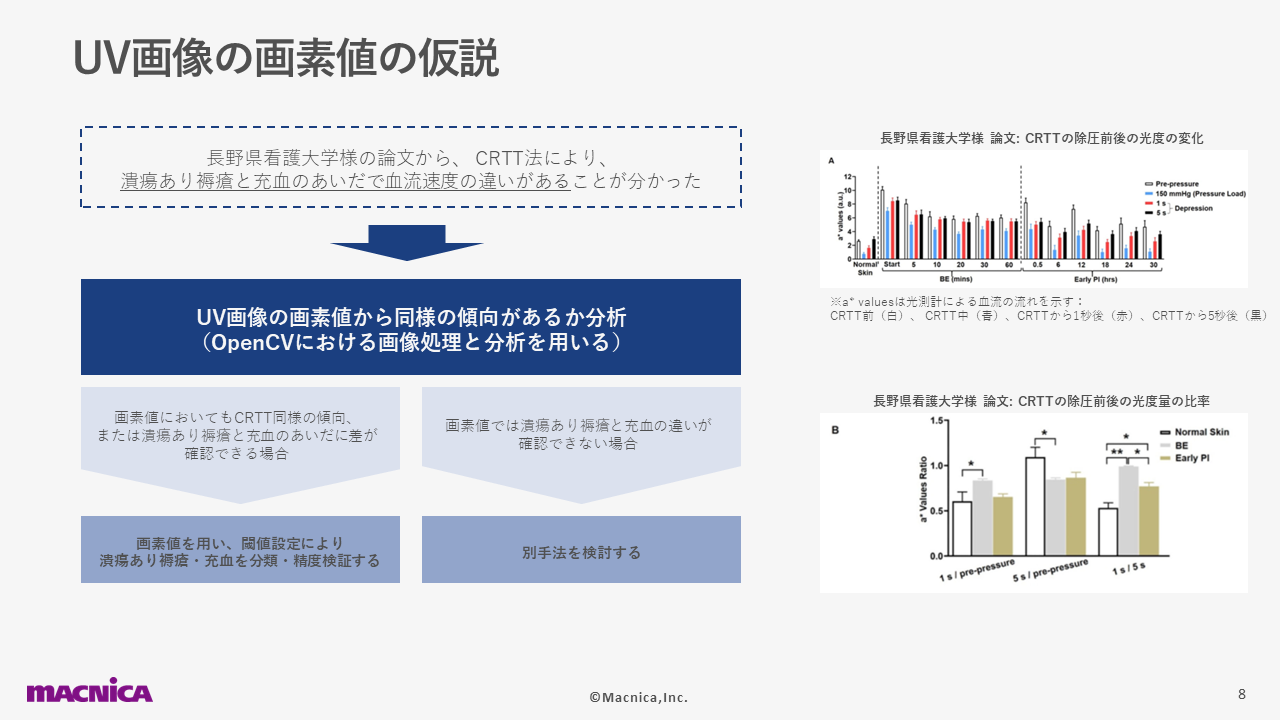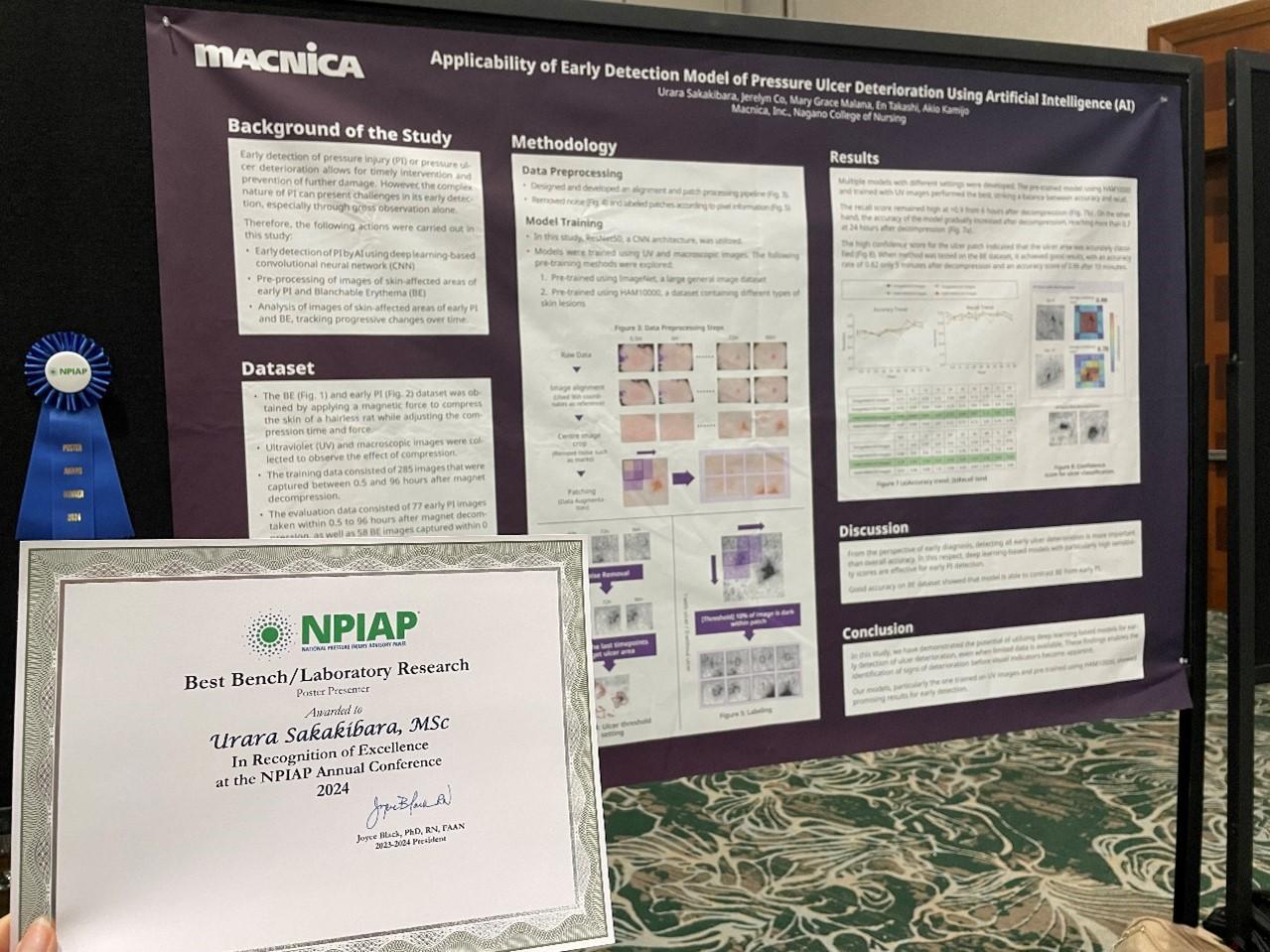
One symptom that has become a problem in the medical field in recent years is "bedsores." As bedsores primarily affect human skin, early treatment is essential. Macnica has been working with Nagano Prefectural University of Nursing, which has been focusing on research into bedsores, on a project that utilizes AI.
This time, Macnica 's Urara Sakakibara and Mary Grace Malana, who are part of the project, talked to us about the initiative.
This article is divided into two parts, with the main focus on the following:
[Part 1]: "Development of an AI model for early detection of bedsores (PoC1)" worked on from June 2022 to March 2023
[Part 2]: Presentation at the NPIAP 2024 Annual Conference (National Pressure Ulcer Advisory Committee Conference: hereafter referred to as NPIAP2024) held in the United States, and the "Development of a machine learning model for early detection of pressure ulcers (PoC2)" that was undertaken from April to September 2023.
* NPIAP is an abbreviation for the National Pressure Injury Advisory Panel. It is an American non-profit organization that brings together experts from various medical fields who specialize in the prevention and management of pressure ulcers. Its goal is to disseminate knowledge to medical professionals, the government, the general public, and medical institutions through the promotion of the latest guidelines and best practices.
About NPIAP2024 and PoC2
-First, please give us an overview of NPIAP2024.
Sakakibara: This is an annual conference held by NPIAP in the US, and features panel discussions related to pressure ulcers, oral presentations by researchers, poster displays, and corporate exhibits. This time, the event lasted for two days, and we used posters to explain the contents of our research to visitors. The corporate exhibits included practical and commercially available products, such as beds that prevent the development of pressure ulcers and dressings that reduce friction. The event is notable for being specialized solely on pressure ulcers, as opposed to being just a part of a typical medical event.
--The fact that specialized events are being held shows that bedsores are indeed considered to be a serious problem?
Sakakibara: I think so. The NPIAP information states, "Our society is accredited by the American Nurses Association and the American Board of Dietetic Registration, and by attending the conference, you can earn the credits necessary to renew your nursing and registered dietitian qualifications." I think this is proof that NPIAP is firmly recognized in the field of pressure ulcers. Most of the people I spoke to were from the United States, but there were probably several hundred people at the venue, including people from Canada and Europe.
-What was Macnica 's purpose in participating in NPIAP2024?
Sakakibara: It is possible to develop and provide solutions using AI in the medical field, and we want to communicate that Macnica is also involved in such efforts.
In September 2023, I also gave a poster presentation at the Japanese Society of Pressure Ulcers, but some of my research was not presented at that time due to application timing issues. I had heard that many authorities in the field of pressure ulcers would be attending NPIAP2024, so I thought it would be very meaningful to present my research there.

--We talked about PoC1 in Part 1. Now, please tell us about PoC2.
Sakakibara: While PoC1 was the development of an AI model for the early detection of bedsores, PoC2 was the development of a machine learning model rather than a deep learning model. However, they have in common the use of rat skin image data.
Bed sores are characterized by the fact that redness is visible from the early stages, making it difficult to distinguish between bed sores and redness that will not develop into bed sores in the early stages. However, when a doctor examines a patient's skin, there are stages where it is difficult to tell whether the skin is just red by chance at that time, meaning that it is okay to leave it alone, or whether the bed sore is actually progressing. To determine this, a method called the "CRTT (Capillary Refilling Time Test)" is used in the medical field, in which the patient's skin is pressed and released with a glass plate or finger, and the color change is visually confirmed.
PoC2 involved photographing the change in color with a UV camera, training a model to learn the characteristics of bedsores through image processing (feature extraction), and then predicting trends in symptoms.

▲ A paper from Nagano Prefectural University of Nursing revealed that blood flow speed differs depending on the condition of the skin. PoC2 research was conducted based on this hypothesis.
Source: Chen, L.; Takashi, E.; Hou, P.; Kamijo, A.; Miura, D.; Fan, J.Elucidation of Ischemic Mechanisms of Early Pressure Injury during Post-Decompression and Detecting Methods. Diagnostics 2022, 12, 2198.

In PoC1, we trained the AI model using skin image data taken at different times, such as 0.5 hours, 6 hours, and 12 hours, but this actually posed a major problem. For example, even if there is skin on which bedsores actually progress, at the 0.5 hour mark it looks clean. However, the AI still needs to learn that there is a bedsore. This confuses the AI, making it think, "Even if the skin is clean, there is a bedsore?"
As a result, we had to train the AI models by time and treat each model separately, such as "only giving images from 0.5 hours to the 0.5 hour model." Furthermore, in actual clinical settings, even if you see skin that is slightly red, it is difficult to tell that "this skin has had bedsore symptoms for x hours." From this perspective, we came to the conclusion that models that are bound by time have operational problems.
On the other hand, if the changes that occur when you press and release the skin at each time point are the same at each point in time, there is no need to use time as a standard. PoC2 was started with this hypothesis in mind.
Winner of the Best Award in the Lab Research Category!
-How did it feel to present at NPIAP2024?
Sakakibara: This time, we presented both PoC1 and PoC2 posters, but we actually won the Best Award in the Lab Research category for PoC1. The organizers of NPIAP2024 knew the content of each exhibitor's presentation in advance, so we were informed of our award before the event, and during the event, a blue ribbon was attached next to our poster as an award marker before the poster presentation began. As a result, many people came to see our poster, and we were able to attract many people who listened to the PoC2 presentation that was being presented next to it.

▲There were apparently around 10 other exhibitors in the Bench/Laboratory Research category in which they won.
I looked at a variety of other presentations, but very few of them used image analysis or AI models, so I think the deciding factor for winning was our ability to differentiate ourselves. Although there are still some aspects of actual operation that we haven't fully thought through, many people were very interested, saying "Wow, AI can do this!" and gave us positive feedback, such as "It would be great if we could see more advances in diagnosis that involve devices and AI models in the future."
Malana: As Mr. Sakakibara said, I also got the impression that many people were interested in the use of cutting-edge AI technology. I think this is also because such technology has not yet become widespread in the field of pressure injury prevention.
--I understand that this is the first time that your department has presented at an academic conference like this, so that's really amazing.
Also linked to COVID-19
--What were your impressions of the other speakers' presentations?
Sakakibara: I noticed two things. The first is that the field of bedsores has also been greatly affected by COVID-19. For example, it seems that bedsores can also be caused by wearing a hard medical mask for a long period of time or having an oxygen tube inserted into the nose. Bedsores are often said to be a problem for people who are bedridden, but I felt that consideration should also be given to patients and medical professionals who wear medical devices.
Secondly, record keeping is extremely important in the field of nursing and care. I heard that in the US, it is strongly recommended to change the position of the person in bed at regular intervals and keep a record of this. If records are not kept and the patient develops a bedsore and needs surgery or treatment, there are cases where the family may sue. However, it seems that the shortage of nurses and caregivers is also an issue in the US, so finding the time to keep records is not easy. I was shocked to learn this reality.
--When it comes to recording, it would be great if that could be solved digitally.
Sakakibara: Yes. Although the purpose is different from this time, I imagined that it would be nice if we could provide one-stop support for digital transformation using AI.
Malana: I also found the perspective of medical devices causing bedsores very interesting. I think cooperation between various stakeholders, including those working in the nursing and care field, engineers like us, and medical device manufacturers, is essential to solving the problem of bedsores across the industry.
-Is there anything you would like to use the knowledge you gained this time in your future work, or any goals you have?
Sakakibara: We would like to continue our efforts to improve the accuracy of the AI and machine learning models we have developed so that we can enter the market as a medical support solution.
Malana: I would like to try new methods of image processing. Until now, I have used images taken with LED and UV cameras, but at NPIAP2024, I saw products that can check the condition of the skin by temperature, like thermography, image collection using invisible light, and methods of collecting information using various sensors. I think that if we can use such technologies effectively, we can advance development more precisely.
We also realized that bedsores look different depending on the skin color. For example, it may be difficult to see redness or early signs of bedsores on darker skin. In such cases, considering the approach of whether to use a UV camera or thermography is a very important point when considering a universal system that can be used by many people.
Summary
This time, in two parts, [Part 1] and [Part 2], we introduced the characteristics of bedsores and the details of the project between Nagano Prefectural University of Nursing and Macnica.
Some of you reading this article may be hearing the term "bedsore" for the first time. I hope I have been able to introduce you to this condition, which is attracting attention in the medical field, and the potential of AI.
Macnica, which is conducting research and development using AI in various fields including medicine, was also able to achieve the brilliant result of winning the Best Award at NPIAP2024 with the cooperation of Nagano Prefectural University of Nursing. We sincerely hope that technology will continue to develop in the future, so that even one person will suffer from bedsores. We will continue to provide various solutions and services that help solve such social issues.